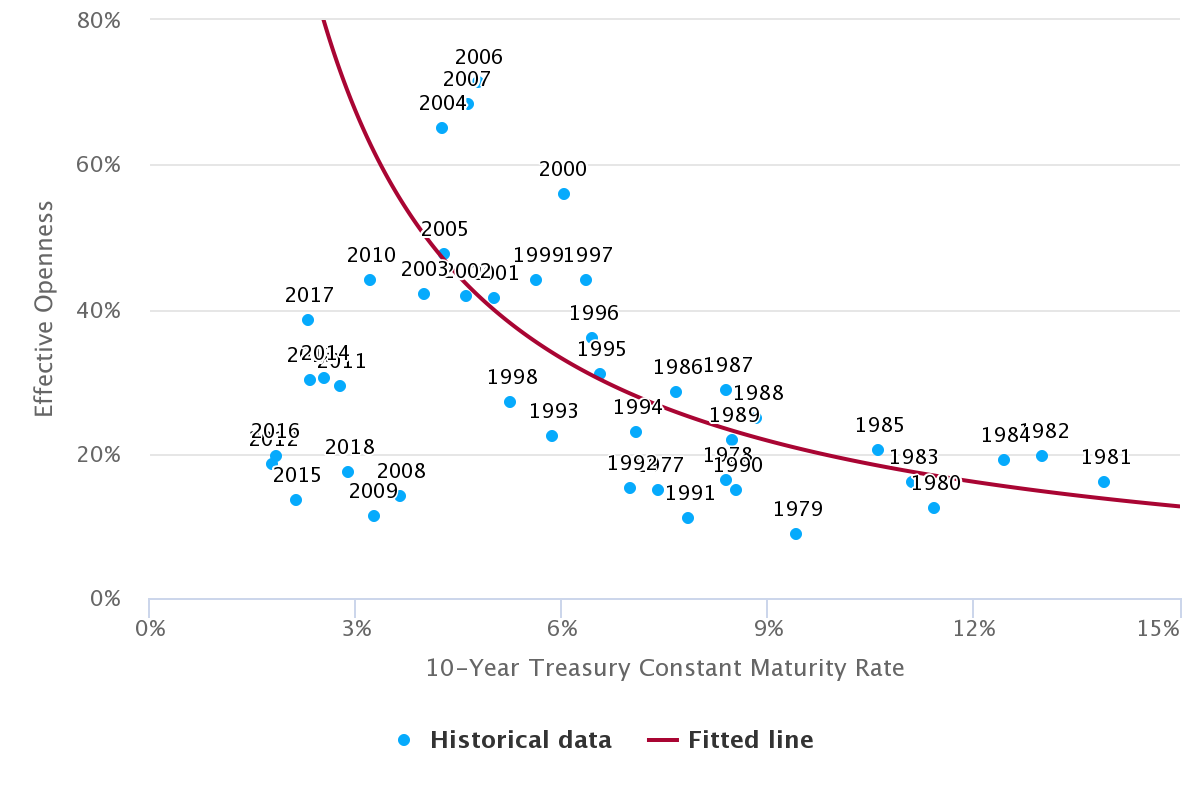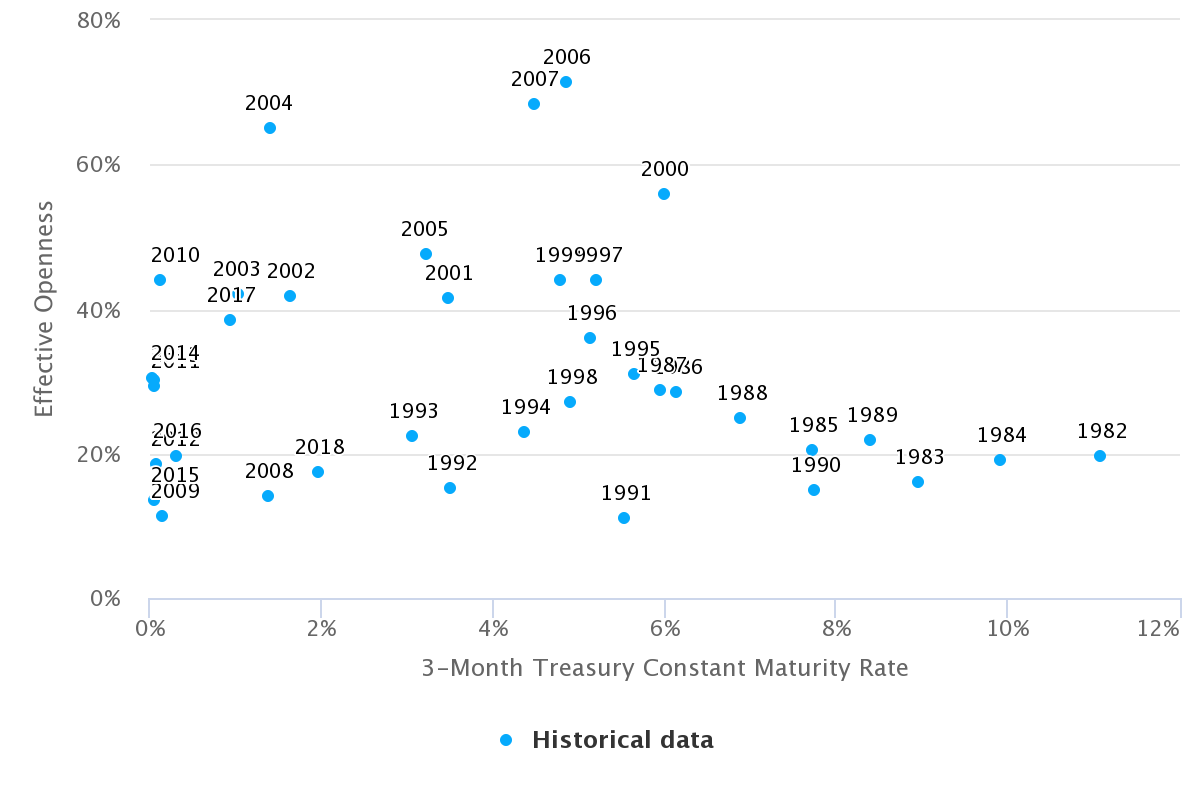We previously defined a measure of effective openness of the U.S. economy to foreign investment flows. We found that, historically, when tariff rates increase, effective openness is lower. Here, we compare the relationship between effective openness and average interest rates on U.S. government bonds with 10-year maturities.1 Figure 1 displays effective openness and 10-year interest rates in each year.

Source: Federal Reserve Bank of St. Louis. Treasury Constant Maturity Rate. Available at: https://fred.stlouisfed.org/categories/115.
Demand for government debt assets by all market participants influences the market interest rate on that debt. All else equal, more demand increases the price of government debt, which is equivalent to a lower interest rate. We examine the relationship between foreign demand, measured as effective openness, and the interest rate.
We abstract from a number of features of the debt market, including the effect of secular changes in the supply of debt by U.S. fiscal policy and major interventions by the Federal Reserve in credit markets. For example, during the Quantitative Easing interventions by the Fed, the Fed aggressively purchased longer maturity assets from 2009-2014. Even after expanding its balance sheet, the Fed continued to rollover its assets until 2018, when it stopped purchasing new bonds as older issues matured.
The fitted line in Figure 1 shows the estimated relationship between effective openness and interest rates on 10-year Treasury debt:2
As the effective openness of the economy increases, interest rates decline. This correlation is consistent with the finding in Warnock and Warnock (2009) that foreign purchases of U.S. government bonds have a significant inverse relationship to long-term interest rates.3
While there appears to be a connection between 10-year rates and effective openness, the relationship between effective openness and short-term rates is less clear. If short-term rates are almost entirely set by policy, we expect effective openness to have little effect on them. In addition, we do not expect a strong relationship because foreign demand for long-term Treasury debt is usually higher than demand for short-term debt.4 Figure 2 displays effective openness and interest rate on 3-month U.S. Treasurys in each year. We find that effective openness and short-term interest rates do not appear to be related unless we exclude periods of easing5 (that is, lowering of the federal funds rate).

Source: Federal Reserve Bank of St. Louis. Treasury Constant Maturity Rate. Available at: https://fred.stlouisfed.org/categories/115.
Our basic empirical analysis of effective openness and federal debt interest rates shows that foreign asset demand has an inverse relationship with long-term interest rates. We previously found an inverse relationship between tariff rates and openness. Thus, in a trade-war scenario, we expect higher interest rates on federal debt, unless the Fed steps in. Higher interest payments on government debt would generate a worse outcome for the U.S. economy, and would, for example, increase the dynamic cost that we previously estimated for the “Tax Cuts and Jobs Act.”
-
Federal Reserve Bank of St. Louis. Treasury Constant Maturity Rate. Available at: https://fred.stlouisfed.org/categories/115. ↩
-
Our nonlinear regression model takes the form of 1/x with an R-squared measure of 0.41. ↩
-
Warnock, F. and Warnock. V (2009), “International capital flows and U.S. interest rates,” Journal of International Money and Finance, vol. 28, pp. 903-919. ↩
-
U.S. Department of the Treasury. U.S. liabilities to foreigners re U.S. Securities. Available at: https://www.treasury.gov/resource-center/data-chart-center/tic/Pages/shlreports.aspx. ↩
-
Federal Reserve Bank of St. Louis. Effective Federal Funds Rate. Available at: https://fred.stlouisfed.org/series/FEDFUNDS. ↩
Year,Effective Openness,10-Year Treasury Constant Maturity Rate
1977,14.882520,7.417631
1978,16.344530,8.408387
1979,8.789809,9.432943
1980,12.553840,11.433440
1981,16.193010,13.921370
1982,19.704980,13.005500
1983,16.120740,11.103000
1984,19.137510,12.458110
1985,20.501090,10.619800
1986,28.616640,7.672840
1987,28.889670,8.392680
1988,24.862590,8.848000
1989,21.790340,8.493720
1990,14.841640,8.552400
1991,11.100410,7.862440
1992,15.263670,7.008845
1993,22.465090,5.866280
1994,23.016010,7.085181
1995,31.036090,6.573920
1996,35.924610,6.443532
1997,44.068480,6.353960
1998,27.172660,5.262880
1999,44.060410,5.646135
2000,55.888970,6.030279
2001,41.533860,5.020686
2002,41.693580,4.613080
2003,42.058710,4.013880
2004,64.979290,4.271320
2005,47.567840,4.288880
2006,71.357430,4.795000
2007,68.243290,4.634661
2008,14.241000,3.664263
2009,11.295330,3.264120
2010,43.957350,3.215060
2011,29.346550,2.781640
2012,18.423290,1.803440
2013,30.182090,2.350160
2014,30.390370,2.539560
2015,13.559910,2.138287
2016,19.792030,1.837440
2017,38.488070,2.329480
2018,17.416940,2.911245
Year,Effective Openness,3-Month Treasury Constant Maturity Rate
1982,19.70498000,11.08992000
1983,16.12074000,8.95132000
1984,19.13751000,9.91855400
1985,20.50109000,7.72383100
1986,28.61664000,6.14636000
1987,28.88967000,5.96488000
1988,24.86259000,6.88592000
1989,21.79034000,8.39456000
1990,14.84164000,7.74648000
1991,11.10041000,5.53960000
1992,15.26367000,3.51434300
1993,22.46509000,3.06600000
1994,23.01601000,4.37249000
1995,31.03609000,5.66036000
1996,35.92461000,5.14559500
1997,44.06848000,5.20144000
1998,27.17266000,4.90696000
1999,44.06041000,4.77760900
2000,55.88897000,5.99992000
2001,41.53386000,3.47866900
2002,41.69358000,1.63532000
2003,42.05871000,1.02804000
2004,64.97929000,1.39872000
2005,47.56784000,3.21612000
2006,71.35743000,4.85156000
2007,68.24329000,4.48095600
2008,14.24100000,1.39685300
2009,11.29533000,0.15092000
2010,43.95735000,0.13844620
2011,29.34655000,0.05284000
2012,18.42329000,0.08760000
2013,30.18209000,0.05708000
2014,30.39037000,0.03272000
2015,13.55991000,0.05251000
2016,19.79203000,0.31936000
2017,38.48807000,0.94896000
2018,17.41694000,1.97168700
